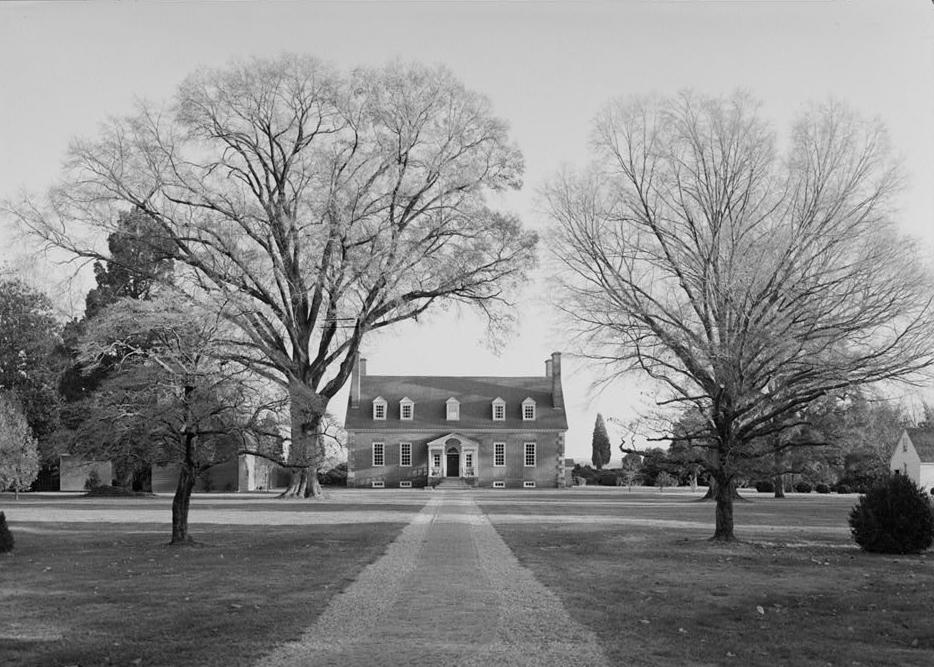Gunston Hall, Mason Neck, Lorton Virginia

Gunston Hall was the home of George Mason, gentleman, planter, and constitutional theorist, a man as influential as any other in building the theoretical underpinnings of the American Revolution and of the Constitution of 1787. He was a model member of the landed gentry, serving on the bench, in the parish vestry, in the Assembly, as well as in the Constitutional Convention of 1787.
George Mason (1725-1792) was the fourth of that name and line in Virginia, his forebearer having settled on 900 acres in the Northern Neck of Virginia on a grant dated 1655. By the time the fourth George Mason came into his inheritance, there were 5,000 acres in the estate. Because of the early death of his father, he was under the guardianship of his mother, Ann Thomson Mason, and his uncle, John Mercer of "Marlborough." Mason's early years were spent in Mercer's library which was rich in the law, accounting for Mason's wide legal knowledge throughout his later career.
In 1750 he married Anne Eilbeck of Charles County, Maryland. They had nine children, five boys and four girls. They began their manor house, Gunston Hall,in 1754, Mason himself planning the shape of the building, the floor plan, and the materials of construction. In 1755 his brother Thomson Mason brought 21 year old William Buckland (see below) back with him on a four year indenture to do the woodwork at the hall. Gunston Hall was completed in 1758 and remains a magnificant example of the joiner's art, the public rooms particularly possessing elaborate decorations of unusual beauty,
Mason ran his plantation himself and regarded his periods of public service as necessary intrusions of duty into his peaceful country life. His first service was to his country and parish: he was a trustee of the Town of Alexandria (1754-1779), a justice of the peace until 1789, a vestryman of Truro Parish (1748-1785), and he supervised the building of Pohick Church. His participation in a wider sphere began when he became a member of the Ohio Company in 1752. His first state paper, "Extracts from the Virginia Charters, with Some Remarks Upon Them" (1773), was a study of Virginia's constitutional claims to the Northwest Territory after the Crown had abrogated the company's charter.
Mason was extraordinarily averse to holding public office, but he served in the House of Burgesses in 1759 and again in 1775, taking George Washington's place after the latter was elected Commander in Chief of the Continental Army. His major contributions to the cause, however, were intellectual. From the time of the passage of the Stamp Act (1765) he had been engaged in an expanding defense of colonial rights. In response to the Coercive Acts, he wrote the Fairfax Resolves calling for joint colonial action, which were passed by his county and by the convention at Williamsburg, and which contributed to the position taken by the Continental Congress. Mason was valued as an adviser by many Virginians seemingly more active in revolutionary events. In 1775 he served on the committee of safety which governed Virginia after the flight of Lord Dunmore. His 1776 Virginia Declaration of Rights was perhaps his most influential document, affecting Thomas Jefferson's Declaration of Independence, the Bill of Rights of the Constitution of 1787, and the revolutionary debates in France, as well. His contributions to the first Virginia state constitution were substantial, and the 1776 document served the state until 1830.
While he served in the Virginia Assembly (1776-1780), he worked for the disestablishment of the Church of England, helped to organize defense measures for the state, as well as Virginia-claimed land in Kentucky and the Northwest, and served on the secret committee which approved George Rogers dark's conquest of the Northwest. He was, by his study of Virginia's claims to the land above the Ohio, as well as by his work toward its conquest and protection, partially responsible for the addition of that vast trans-montaine area to the Nation.
After becoming dissatisfied with the operation of the Articles of Confederation, he served as a member of the Constitutional Convention of 1787, where he labored long and hard to bring in a liberal document. He was dissatisfied with the completed constitution because it failed to outlaw the slave trade immediately, because it gave too much power to Congress, and because it had no Bill of Rights, so he refused to sign it and went home to work against its ratification. In the struggle over ratification, the Virginia convention suggested a group of ammendments to the new United States Constitution (the Bill of Rights).
After his work on the Constitution Mason refused to be drawn back into the public arena, preferring instead to live his life out at Gunston Hall. He died there October 7, 1792, having quietly done as much as any other man in that remarkable generation to secure a rule of reason and law for his compatriots and to see to it that the rights he helped to forge were written into our state papers.
Gunston Hall passed from the Mason family in 1867 and went from owner to owner until 1912 when it was purchased by Louis Hertle. Mr. Hertle did some restoration on the house and grounds. In 1932 he conveyed title to the Commonwealth of Virginia in fulfillment of the wish of his late wife so that the plantation could be preserved as a shrine to the ideals of George Mason. The house and grounds are maintained by the National Society of Colonial Dames and are open to the public.




